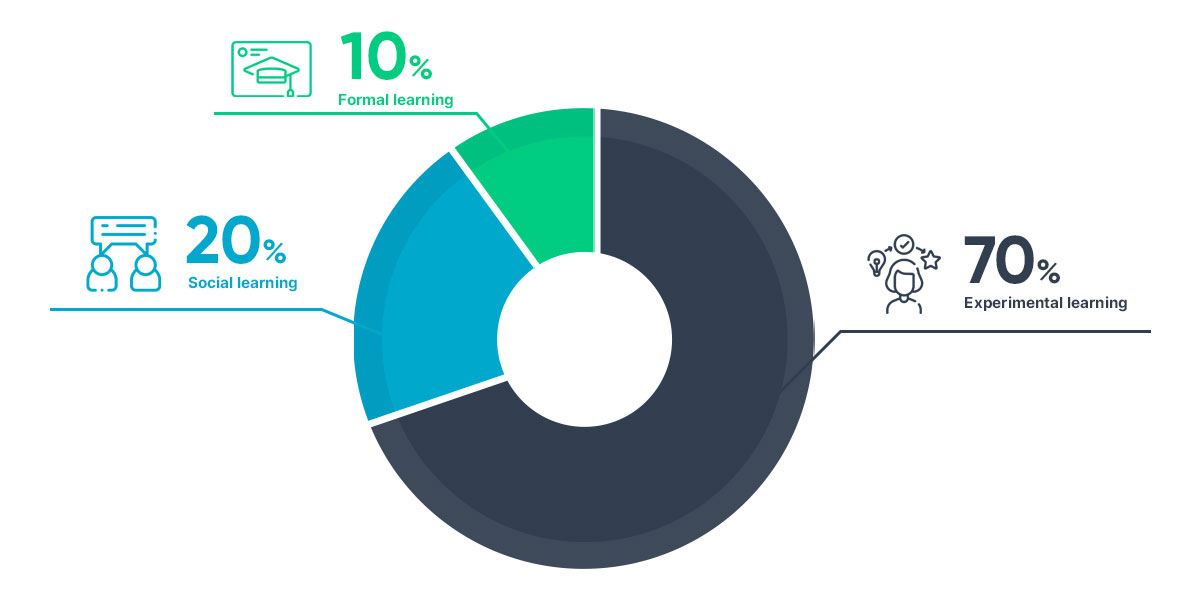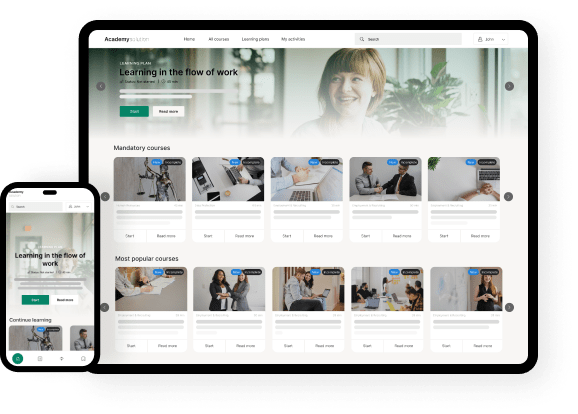In corporate, competencies are often built through various activities. We learn through a mixture of structural training, co-dependent learning, and through practical execution of work tasks. In this blog post, we take a closer look at how you, as a leader, can use principles from the 70-20-10 model for competence building.

Using the 70-20-10 model requires more than just showing employees how to perform a task. To build competencies, we must create a holistic learning environment in which employees can learn through experience, supportive colleagues, and formal education. But how do you put this into practice?
1. List the competencies you need
If you haven’t yet examined the competencies already found in your organization, it’s a good place to start. Mapping out your organization’s competency gap(s) takes bit of a math. However, start by describing the competencies that exist today, and then compare these to the competencies that you desire to have in the future. The competencies that lies therebetween is your competence gap.
Once you know what expertise you need, you can create a list of what is most urgent. Then start at the top of the list and work your way down.
As an example, we have chosen to focus on presentation skills improvement.
Increasingly more people in the workplace are required to give presentations, lectures, talks, and train employees. However, to be able to present a message in a convincing way while maintaining the audience’s attention, requires good presentation techniques. In the following, let’s imagine that you have identified a need for improving this skill within your company.
2. Get everyone on board
For your learning project to be successful, it is important that everyone is on board. You can achieve this by explaining the importance of the 70-20-10 model so that everyone sees the value of participating. This is a great method to facilitate mixed learning. For example, to help them understand the theory behind the model, you can refer to this blog post.
As management can be of invaluable support to your employees, it is especially important that you have this department behind you. Managers must be willing to share both their knowledge and time with employees in order to develop a team’s competencies.
It will take a little extra time and effort before everyone has adapted to a new way of learning, but it will be worth it!
3. Base your learning process on the 70-20-10 model
Before you start any kind of competence building, it is important that you structure the learning process. At Cursum, we believe that the 70-20-10 model can help you.
Divide the learning process into these three types of learning:
- 10 % formal learning
- 20 % social learning
- 70 % experimental learning
We suggest you begin with formal learning, as employees need knowledge and information to be able to build their presentaion skills.
Formel learning:
- Review how to create a good PowerPoint presentation.
- Offer courses on how to set up, prepare for, and carry out a presentation, and give tips on how to control one’s nerves before a presentation.
Social learning:
- Gather small groups of 2-3 learning partners or buddies who can train and learn together.
- Switch between presenting and observing each other.
- Comment on each other’s presentations.
Experimental learning:
- Ask each employees to prepare and present a separate presentation based on a real-life situation or matter of relevance to the company.
- Encourage them to apply what they have learned from formal and social learning.
- Have them present the presentation during a meeting where it is natural to do so.
- Bring learning partners or buddies to the meeting so they can provide constructive feedback afterwards.
4. Start the learning process
Once you have made a plan and everyone is on board, you can start the learning process. Based on the example above, you can start by making a step-by-step description of what a good presentation should include. Then you can plan a course covering good presentation techniques. Think about what you want it to contain and what visual aids you want to use. An effective learning method may be to first show an example video that demonstrates a poorly executed presentation. Next, you can follow up with an example of a well executed presentation.
After the course, employees can practice what they have learned. This can be advantageous to do in smaller groups of 2-3 employees since it allows for a safe environment.
Finally, each employee should be given the opportunity to present during a meeting where it will feel natural and not staged.
Enter all this in your company’s LMS, and remember to inform all parties involved of the plan. It is important that everyone knows the time frame and are aware of what is expected from them.
Department managers need to know where and when to take the lead. And each employee must understand that they themselves are responsible for building their own competencies and therefore must engage in all parts of the learning process for maximum benefit. It is also their responsibility to ask for feedback from employees and share constructive feedback with others during the learning process. The more they engage themselves, the more they will learn and develop their skills.
5. Monitor progress and adjust as needed
Always pay close attention to how the competence building training proceeds.
Using an LMS, you can track each employee’s progress with its reporting tools. But it is also important to gather feedback from managers.
If you find that several employees are struggling with a particular part of the learning process, you should explore what can be adjusted to make that part easier.
Once you know what works best for your organization, you can update your original learning process and use it for competence building in another area.
Remember to review the learning processes on an ongoing basis and monitor whether you are achieving the results you want. Do not be discouraged and do not give up if the results are not as expected. Use what you have learned to adjust and optimize how you use the 70-20-10 model until you find a strategy that fits your situation.
Are you ready to start building competencies within your organization? But are you unsure where to start or how to implement an LMS? Contact us and we will help you get started.
This blog post is based on the book “How to Leverage the 70 20 10 Model for High Performing Employees”.


